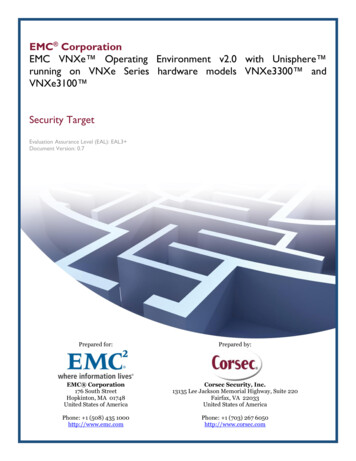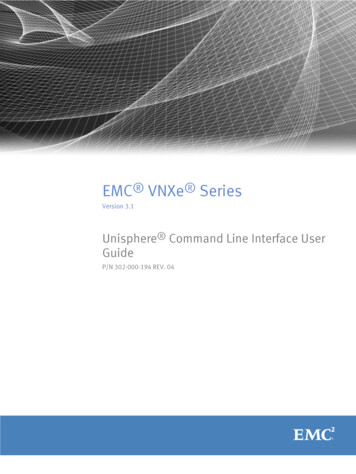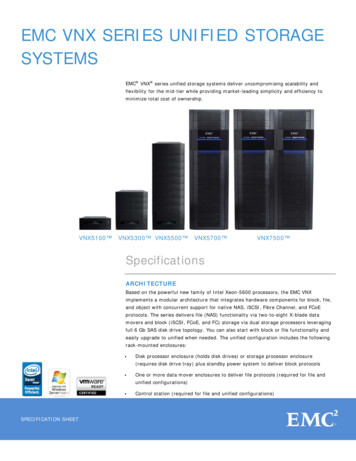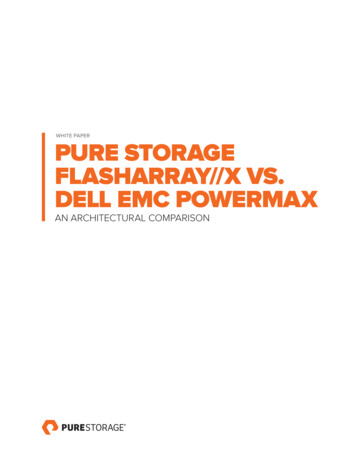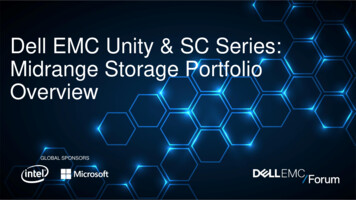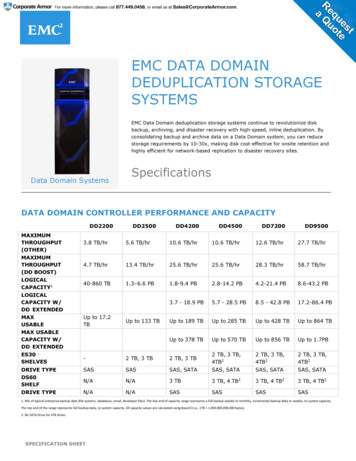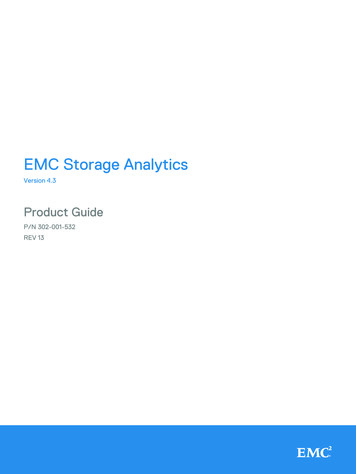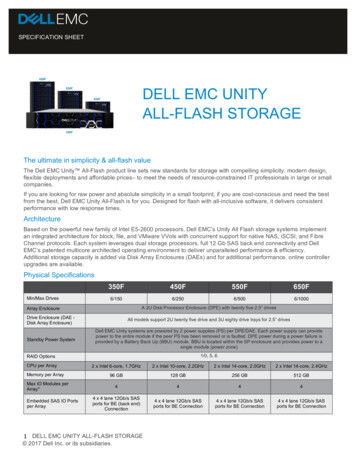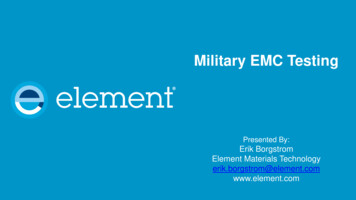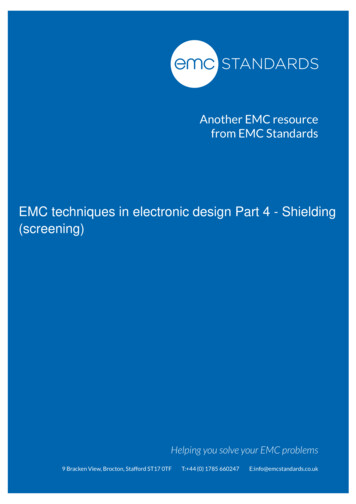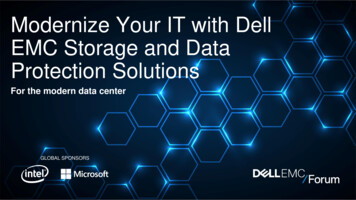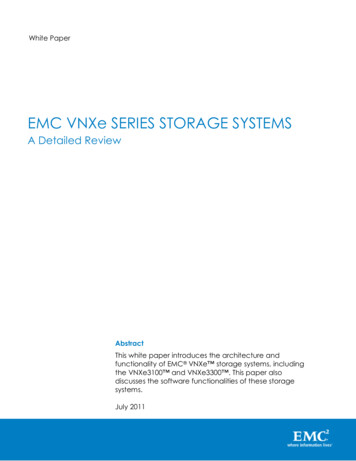
Transcription
White PaperEMC VNXe SERIES STORAGE SYSTEMSA Detailed ReviewAbstractThis white paper introduces the architecture andfunctionality of EMC VNXe storage systems, includingthe VNXe3100 and VNXe3300 . This paper alsodiscusses the software functionalities of these storagesystems.July 2011
Copyright 2011 EMC Corporation. All Rights Reserved.EMC believes the information in this publication isaccurate of its publication date. The information issubject to change without notice.The information in this publication is provided ―as is‖.EMC Corporation makes no representations orwarranties of any kind with respect to the information inthis publication, and specifically disclaims impliedwarranties of merchantability or fitness for a particularpurpose.Use, copying, and distribution of any EMC softwaredescribed in this publication requires an applicablesoftware license.For the most up-to-date listing of EMC product names,see EMC Corporation Trademarks on EMC.com.VMware, ESX, and VMware vCenter are registeredtrademarks or trademarks of VMware, Inc. in the UnitedStates and/or other jurisdictions. All other trademarksused herein are the property of their respective owners.All other trademarks used herein are the property oftheir respective owners.Part Number h8178.3EMC VNXe Series Storage SystemsA Detailed Review2
Table of ContentsExecutive summary . 4Audience . 4Terminology . 5VNX unified storage family . 6VNXe series . 7Hardware overview . 10Software overview . 14Connection Utility and Configuration wizard . 14Unisphere . 15Storage provisioning. 16Exchange storage . 18Shared folders . 19Generic iSCSI storage . 20VMware storage . 21Hyper-V storage. 22Storage pool characteristics. 22Data protection . 26Snapshots. 26Replication . 28Backup and restore . 30CLI support. 30Advanced features . 31Link aggregation . 31Thin provisioning. 31File-Level Retention (enterprise) . 33Deduplication . 34Virus protection . 34User management . 35LDAP integration . 35High availability . 36The VNXe series support ecosystem . 37Conclusion . 38References . 39EMC VNXe Series Storage SystemsA Detailed Review3
Executive summaryBusinesses continue to experience exponential growth in storage-capacitydemand as well as require 24x7 availability. Research shows thatcompanies are experiencing, on average, greater than 50 percent annualinformation growth. Most of this growth is happening with unstructureddata, such as files.Increased complexity is common as IT departments continue to addadditional servers and applications, and move to a more virtualizedenvironment. Solutions that help organizations better utilize servervirtualization are compelling. Traditional storage management is often toocomplicated for businesses. Allocating and managing storage oftenrequires an understanding of complicated storage terminology andspecialized training for storage administrators. While the complexity of ITenvironments continues to increase, the service level demanded by ITusers remains high. The increased cost of equipment, people, and facilitiescontinues to be a challenge for IT generalists.The EMC VNXe series is a new unified storage solution for SMB andlower mid-market organizations and remote/branch offices (ROBO) inenterprise organizations. It addresses the challenges mentioned above.Designed for IT generalists with limited storage expertise, the VNXe seriesfacilitates complete storage consolidation with advanced file and blockfunctionality as well as a simple, application-driven approach tomanaging shared storage. The VNXe series delivers significantadvancements in efficiency, simplicity, and affordability. Major benefits ofVNXe series storage systems include:Support for file (CIFS and NFS) and block (iSCSI) storageSnapshots and replication (local and remote)Application-focused provisioning, and built-in best practicesVMware and Hyper-V server integrationA new Unisphere interface for simplified managementThis white paper provides an overview for VNXe series storage systems.AudienceThis white paper is intended for EMC employees, partners, IT planners,storage architects, administrators, and any others involved in evaluating,acquiring, managing, operating, or designing an EMC networked storageenvironment using VNXe storage systems.EMC VNXe Series Storage SystemsA Detailed Review4
TerminologyCommand line interface (CLI) – An interface that allows you to dostorage-related tasks using commands typed into a command line.Common Internet File System (CIFS) – An access protocol that allowsusers to access files and folders from Windows hosts located on anetwork. User authentication is maintained through Active Directoryand file access is determined by directory access controls.Deduplication – The process used to compress redundant data,allowing space to be saved on a file system. When multiple files haveidentical data, the file system stores only one copy of the data, andshares that data between the multiple files.Link aggregation – A high-availability feature that allows Ethernet portsthat are associated with the same switch and have similarcharacteristics to combine into a single virtual device/link. Theaggregated link may have a single IP address or multiple IP addresses.Local replication – Replication between two storage servers within thesame VNXe system.iSCSI protocol – The Internet Small Computer System Interface (iSCSI)protocol provides a mechanism for accessing raw block-level datastorage over network connections. The iSCSI protocol is based on anetwork-standard client/server model with iSCSI initiators (hosts) actingas storage clients and iSCSI targets acting as storage servers. Once aconnection is established between an iSCSI host and the iSCSI server,the host can request storage resources and services from the server.iSCSI server – A VNXe server that uses the iSCSI protocol to manageMicrosoft Exchange storage groups, generic storage virtual disks, HyperV datastores, and VMFS-based VMware datastores.Network File System (NFS) – An access protocol that allows users toaccess files and folders from Linux/UNIX hosts located on a network.Network Data Management Protocol (NDMP) – A standard for backingup file servers on a network. It allows centralized applications to backup file systems running in a customer environment.Remote replication – The replication of stored data from one VNXesystem to another (remote) VNXe system or VNX /Celerra system.Server Message Block (SMB) – The underlying protocol used by CIFS torequest files, print, and communicate with a server over a networkthrough TCP ports. VNXe storage systems support Microsoft‘s ServerMessage Block (SMB) 2.0 for CIFS shares. The SMB 2.0 protocol supportsEMC VNXe Series Storage SystemsA Detailed Review5
all characters from the Unicode 3.0 standard on systems runningMicrosoft Windows Server 2008 and Microsoft Windows 7.Share – A named, mountable instance of shared-folder storage,accessible through a shared folder or VMware VMFS datastore. Eachshare is accessible through the protocol (NFS or CIFS) defined for theshared folder where it resides.Shared folder – A VNXe storage resource that provides access toindividual file systems for sharing files and folders. Shared folders containeither Windows shares (which transfer data according to the CIFSprotocol) or NFS shares (which transfer data according to the NFSprotocol). NFS shares are sometimes referred to as NFS exports.Shared-folder server – A VNXe server that uses either the CIFS or NFSprotocol to catalog, organize, and transfer files within designatedshares. A shared-folder server is required to create shared folders thatcontain CIFS or NFS shares, or NFS VMware datastores.Snapshot – A read-only, point-in-time copy of data stored on thestorage system. You can recover files from snapshots or restore astorage element to a snapshot.Storage pool – A storage pool is a collection of disk drives configuredwith a particular storage profile. The storage profile defines the type ofdisks used to provide storage, as well as the type of RAID configured onthe disks. The storage pool‘s configuration defines the number of disksand quantity of storage associated with the pool.Storage processor (SP) – A hardware component that provides theprocessing resources for performing storage operations such ascreating, managing, and monitoring storage resources.Unisphere – A web-based management environment for creatingstorage resources, configuring and scheduling protection for storeddata, and managing and monitoring other storage operations.Virtual Provisioning – A VNXe storage feature used to allocate storageon an as-needed basis from a larger reserved resource. The portion ofthe total resource that the storage element initially uses is called its initialallocation.VNX unified storage familyThe VNX family is the next generation of EMC‘s midrange and low-endstorage platforms. The VNX family (Figure 1) includes the VNX series andthe VNXe series.EMC VNXe Series Storage SystemsA Detailed Review6
Figure 1. Models in the VNX familyThe entry-level VNXe series includes two models: the VNXe3100 and theVNXe3300 . These entry-level offerings provide storage over an IPnetwork. They support the iSCSI, CIFS, and NFS protocols. The small footprintand affordable price of the VNXe make it well suited for small to mediumbusinesses as well as remote-branch offices interested in consolidatingstorage of Exchange, VMware, Hyper-V, and file servers. The VNXe isdesigned for the IT generalist with no specific storage knowledge. Thenewly designed management interface, Unisphere, is intuitive and enablesapplication administrators to perform storage provisioning, management,and monitoring at the application level. Unisphere provides a centralizedGUI that makes the VNXe storage systems easy to manage, and itintegrates with VMware and Hyper-V servers in the environment.The VNX series is designed for midsize to enterprise environments. It beginswith the VNX5100 , which is specialized with Fibre Channel-only front-endconnectivity. The VNX5300 through VNX7500 can be configured for file,block, or unified (which includes file and block) environments. Optimizedfor virtual environments, the VNX models are simple, efficient, andpowerful. The EMC VG2 and VG8 platforms should be used for thoseenvironments that require gateway access to a single or multipleSymmetrix , CLARiiON , or VNX arrays, or a combination thereof. For moredetails about the VNX series, refer to the Introduction to EMC VNX SeriesStorage Systems white paper available on EMC Powerlink .VNXe seriesThe VNXe series storage systems provide a consolidated platform forprovisioning, managing, and monitoring application data storage withinorganizations and networks of all sizes. Each storage system provides highlyEMC VNXe Series Storage SystemsA Detailed Review7
efficient iSCSI block storage and highly accessible file-based storage forenabling users to work with files and data over network connections.VNXe provides access to storage resources through the followingprotocols:iSCSI – Block-level data storage resources accessible through the iSCSIprotocol over a network connection. Optional support for CHAPclient/server authentication and iSNS discovery and management isalso available.Network-attached storage (NAS) – File-based storage for a wide rangeof clients and applications that access storage over networkconnections. Protocol-specific file systems are located and managedon the storage system, which transfers data to hosts over TCP/IP usingthe CIFS and NFS file sharing protocols.VNXe storage systems provide storage resources suited to the needs ofspecific applications, host operating systems, and user requirements.Unisphere can be used to create, configure, and monitor the followingtypes of storage resources:Microsoft Exchange – Provides a resource for storing MicrosoftExchange databases, log files, and public folders based on simpleparameters such as the number of users and the average user mailboxsize.Shared folder – Allows hosts to store data and easily access sharedfolders and shares that integrate seamlessly into: Windows environments that use the CIFS protocol for file sharing,Microsoft Active Directory for authentication, and Windows directoryaccess for folder permissions Linux/UNIX environments that use the NFS protocol for file sharingand POSIX access control lists for folder permissionsGeneric iSCSI – Provides generic block-level storage for hosts andapplications that use the iSCSI protocol to access storage in the form ofvirtual disks.VMware – Provides storage for VMware virtual machines throughdatastores that are accessible through the NFS protocol or VMFS (overiSCSI) protocol.Hyper-V – Provides storage for Hyper-V virtual machines, including theirvirtual hard drives, configuration files, and snapshots, throughdatastores that are accessible to Windows Server 2008 hosts using theiSCSI protocol.EMC VNXe Series Storage SystemsA Detailed Review8
VNXe series storage systems support high-performance SAS drives andbalanced-performance/capacity Near-Line SAS (NL-SAS) drives. Storagepools can be created from these drives to assign storage to hosts andapplications.Figure 2. Models in the VNXe seriesThe VNXe is an ideal platform for businesses with physical serverinfrastructures, as well as those making the move to server virtualization todrive consolidation and greater efficiency. The VNXe3100 is the entry-levelVNXe storage system that provides high value for smaller userconfigurations and lighter performance needs. It is designed to supportsmaller businesses and applications with up to 300 users (dual SPconfiguration) or up to 150 users (single SP configuration). The VNXe3300includes all the ease of use and application-driven management featuresof the VNX3100, along with increased performance, scalability, and I/Oexpandability for use with larger configurations with higher performancedemands. It is designed to support larger businesses and applications withup to 1,000 users. Both systems share a comprehensive set of featuresincluding increased capacity utilization, data protection, and availabilitysolutions, and advanced support capabilities.Some of the major benefits of VNXe series storage systems include:Storage consolidation: VNXe systems align storage management withapplications by embedding best practices into the user interface andproviding a faster, simpler user experience in completing everydayadministrative tasks.Simple and efficient, unified storage: VNXe systems deliver unified IPstorage for NAS and iSCSI environments. Application-centricmanagement and provisioning wizards result in immediate familiarity forusers, while integration of snapshot and replication with storagemanagement workflows results in streamlined operations and uniformdata protection coverage.Compact storage platform: VNXe systems provide a highly availabledesign, where dual controller designs fit in only 2U or 3U of rack space.EMC VNXe Series Storage SystemsA Detailed Review9
Other features of the VNXe series are explained in the following sections.Hardware overviewVNXe3100 systems can scale from one storage processor supporting up to48 disks to two storage processors supporting up to 96 disks. In singlestorage-processor models of VNXe3100, a cache protection module in theempty storage-processor slot maintains a copy of write cache content.You can upgrade a single SP VNXe3100 system to a dual SP VNXe3100system while keeping the original data in place; however you will not haveaccess to that data during the upgrade.VNXe3300 systems have two storage processors that support up to 120disks. In both models, you can add additional disks by daisy-chaining diskarray enclosures (DAEs) on the single SAS back-end bus. Table 1 comparesthe hardware features of these two storage-system models.EMC VNXe Series Storage SystemsA Detailed Review10
Table 1. VNXe3100 and VNXe3300 detailsVNXe3100VNXe3300Single SPDual SPNumber of SPs122Form factor (min)2U2U3UMax number of DAEs377Min / max numberof drives6 / 486 / 966 / 120Drive options300 GB 15k rpm SAS100 GB Flash*600 GB 15k rpm SAS300 GB 15k rpm SAS1 TB 7.2k rpm NL-SAS600 GB 15k rpm SAS2 TB 7.2k rpm NL-SAS1 TB 7.2k rpm NL-SAS*2 TB 7.2k rpm NL-SASDrive enclosureoptions12 x 3.5” SAS / NL-SAS drives15 x 3.5” Flash* / SAS / NL-SASdrivesCPU1 x Intel XeonDual Core2 x Intel XeonDual Core2 x Intel Xeon Quad CoreMemory per system4 GB8 GB or 16 GB*24 GBBack-end connection/ number of back-endports6 Gb SAS / 16 Gb SAS / 1Embedded I/O portsper SP2 x 1 GbE4 x 1 GbEConfigurable I/Oslots per SP11Port options per FlexI/O modules4 x 1 GbE4 x 1 GbE, 2 x 10 GbERAID options1/0, 5, 61/0, 5, 6ManagementLAN 2 x 10/100/1000 Copper GbELAN 2 x 10/
and monitoring at the application level. Unisphere provides a centralized GUI that makes the VNXe storage systems easy to manage, and it integrates with VMware and Hyper-V servers in the environment. The VNX series is designed for midsize to enterprise environments. It begins with the V
